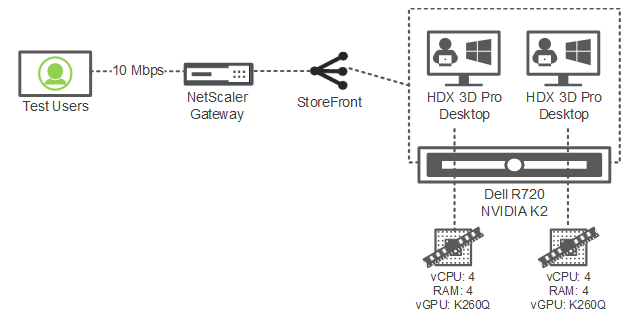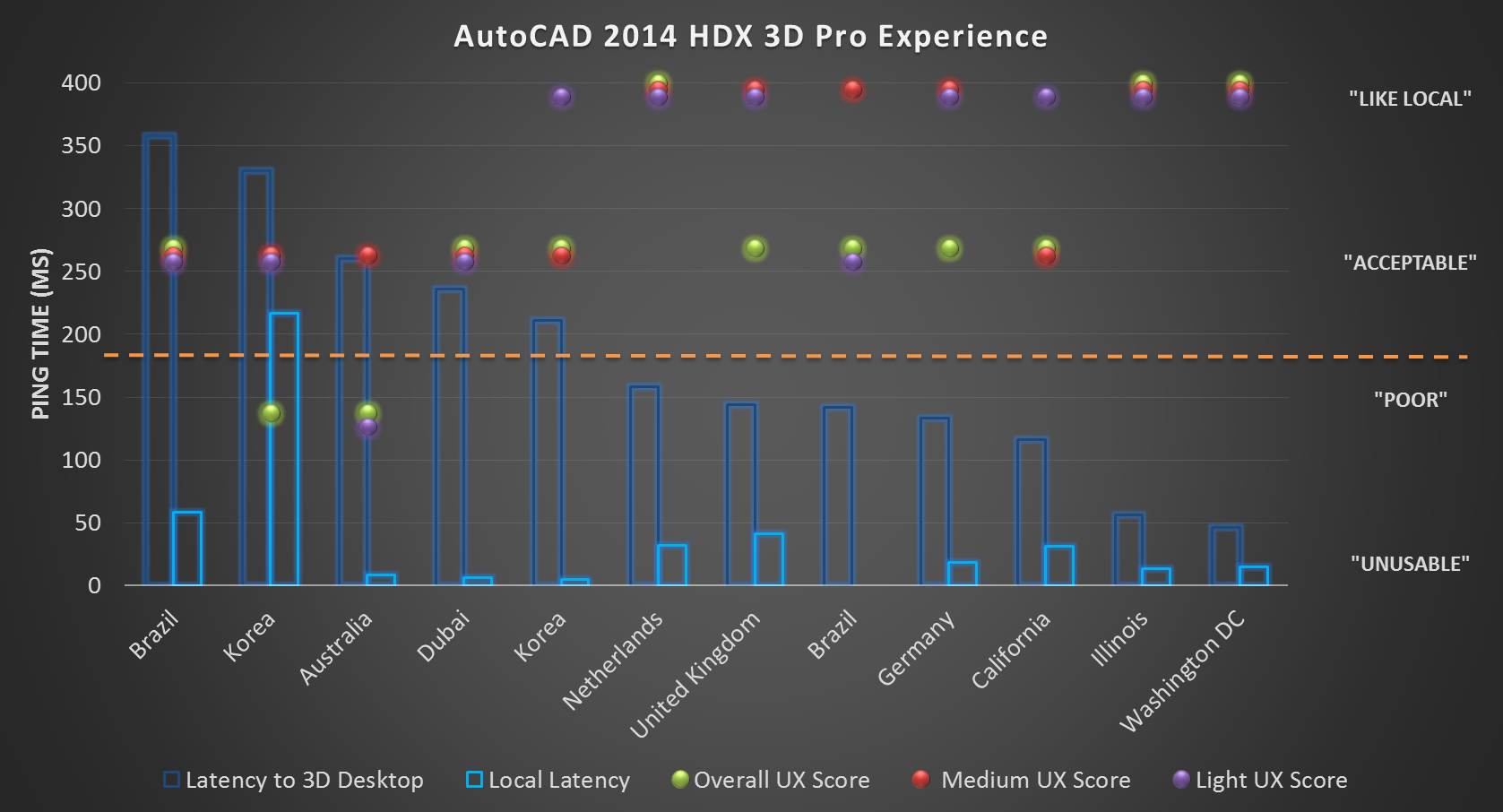Last year I published a series of blogs on the bandwidth requirements of XenApp and XenDesktop and some of the policies and optimizations you can implement to get the most over the WAN. Since then, I have received a lot of questions regarding the bandwidth required for HDX 3D Pro. Now bandwidth requirements in general are very much an “it depends” type of question, but with HDX 3D Pro that answer applies even more.
I recently had access to a Dell R720 which I would like to thank Dell very much for loaning us and a couple of NVIDIA K2 cards to go with it. I would also like to thank Peter Smeryage who works in the Consulting Solutions lab for all his work setting up the hardware. With the R720 and GRID cards I was able to put together a demonstration which I will share here today on why it depends so much and discuss what to consider if delivering HDX 3D Pro outside of the LAN. This post is meant to drive discussion on the topic and I encourage you to post in the comments and complete a short survey at the ends of the post to share your own experiences. That being said, I will take you through the demonstration below.
Configuration:
For the purposes of discussion in the rest of this post, the hardware and software used is as follows:
- Hardware: Dell R720 with 192GB RAM and Intel Xeon 16 Cores @2.60 GHz
- GPU: vGPU Profile K260Q (4 desktops per NVIDIA K2)
- Hypervisor: XenServer 6.2 SP1
- XenDesktop VDA: HDX 3D Pro 7.1
- VM Specs: 4 vCPU and 4GB RAM
- Desktop OS: Windows 7 SP1
- 3D Platform: AutoCAD 2014
No Citrix policies were applied and the desktop was delivered without disabling any visual effects due to the fact that HDX 3D Pro desktops would typically mimic a power machine. A simplified diagram is shown below.
Set-Up
Using the configuration detailed above, Windows 7 desktops hosted in the Citrix Consulting lab in Fort Lauderdale, Florida were provided to users (fellow Citrix employees) in multiple locations worldwide and accessed through NetScaler Gateway. These users were given a test script to execute in which they accessed the desktop and performed various actions using AutoCAD 2014. The script was accompanied with a short survey on the experience while at the same time, I captured various metrics on the session including latency, the end-point connection, and session resolution.
The script which users followed, along with commentary on the bandwidth and user experience is available in the form of a video which you can watch below. When watching the video, note that the overall network out of the lab was 10Mbps and that the point of the exercise was not to nail down a number on how much bandwidth is required for HDX 3D Pro, but to demonstrate how it can fluctuate and how to get a rough estimate as a starting point. In the video and in the chart later in this blog post, please note that I will be referring to Light, Medium, Heavy, and Overall User Experience (UX) scores, corresponding to the three files shown in the video.
Experience
When discussing the user experience, I first want to mention a couple of points for the sake of transparency. The first is that since these are real users, the results are subjective based on their expectations. The second is that these users are not typical AutoCAD users, but are fellow Citrix employees that were willing to spare their time to run through my test. That being said, we here at Citrix tend to have very high expectations when it comes to user experience which makes some of the scores below quite impressive in my opinion.
Below you will find a very colorful chart and corresponding explanation highlighting the results of the test:
- All users are noted by their location and sorted in decreasing latency to the lab environment in Fort Lauderdale, Florida.
- The User Experience (UX) scores are based on the three files used in testing. The overall UX score was in line with the “heavy” score and therefore “heavy” was left out of the chart.
- Latency is a major consideration when deploying to the WAN, but as can be seen below in this example, it is especially important to consider when delivering HDX 3D Pro.
- The quality of local connections plays an important factor as well and was recorded using Speedtest.net. In this case the highest latency to the lab also corresponded to the highest local latency. Although the quality and reliability of a WAN connection can be controlled, remote users on Wifi (most of the test users) require additional consideration.
- The intensity and complexity of what is being delivered to the end point will affect both the bandwidth required and the threshold at which the experience may begin to degrade. This is why understanding the application being delivered and how the users will interact with it is so important with HDX 3D Pro. Within AutoCAD you can see different results below based on the different interactions the users perform.
- The average bandwidth for the test users was just under 500kbps. This is not necessarily indicative of the bandwidth required for HDX 3D Pro or AutoCAD 2014 as there are so many use cases. Of course do not forget the difference between the average and burst requirements which you can read more about in the Virtual Desktop Handbook.
Deploying 3D Apps?
So based on the information above, what should you do to plan a deployment of your 3D applications? My recommendations are as follows (nothing too new here, just applies to 3D apps even more):
- Understand your users. Knowing the expectations and requirements of your users will help ensure you can deliver the same level of quality using HDX 3D Pro. Think of this scenario as an example: “Users currently need to wait 5 minutes every morning before they can begin working because very large files must be loaded from the database over the WAN”. What if that wait was cut to less than 30 seconds by placing the virtual desktop in the LAN and letting HDX 3D Pro deliver the desktop to any device?
- Understand your applications. How much time do users spend actively on the 3D application you plan to virtualize? How many users access it at the same time? If they will be sharing the GPU and the network, this is very useful information to have. Consider using a tool like SysTrack from LakeSide to get these types of metrics locally. It could give you the insight to make decisions on how to best design the solution.
- Test your application. Perform a short test with each 3D application you plan to deliver. Work with your users to understand how to test it and get a starting point of the bandwidth requirements. Even a short test with Performance monitor will tell you enough to get you started with a rough estimate.
- Know your network. This is important for so many reasons, but in this case it will help you to understand what capacity you currently have and if that will suffice for your deployment. Don’t forget to take into account if virtualizing your applications will save you bandwidth somewhere else. Ask yourself the following questions.
- Are large 3D files being sent over the WAN? If so, how much bandwidth would I save by moving the application into the datacenter?
- Based on my latency, should I deliver these apps from two datacenter instead of one?
- Pilot. Once you have the applications ready, pilot them out with a few users. Work with those users to ensure they have a great experience before a full rollout. During the pilot, consider monitoring the traffic to so that you can refine your estimates on the overall requirements. Many times HDX 3D Pro is used to deliver mission critical applications so putting in a little planning beforehand can save the day later on.
We have had many successful customer deployments with HDX 3D Pro and if you have had experience deploying 3D applications through HDX 3D Pro and are willing to share them, please fill out the short survey as we are always looking to hear about production deployments.
Thanks for reading,
Amit Ben-Chanoch
Worldwide Consulting
Desktop & Apps Team
Project Accelerator
Virtual Desktop Handbook
Follow @CTXConsulting





